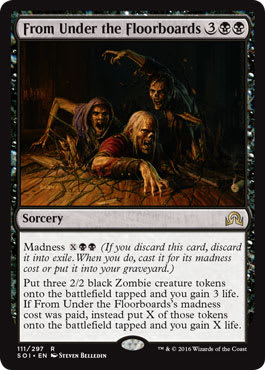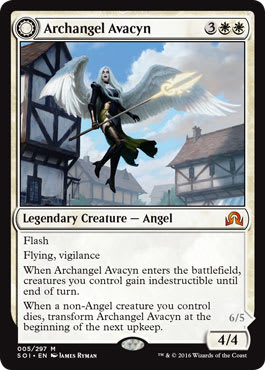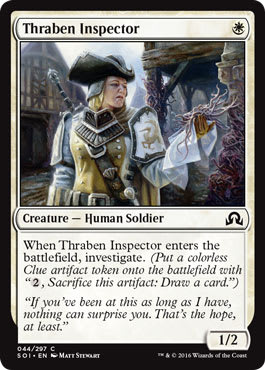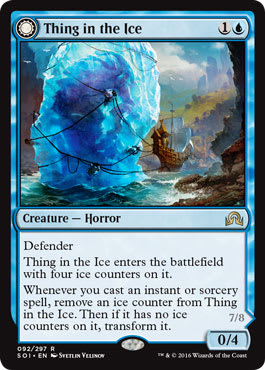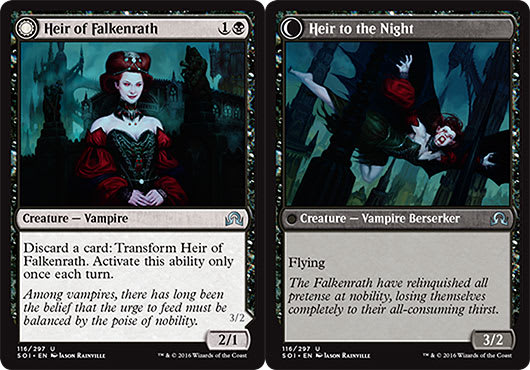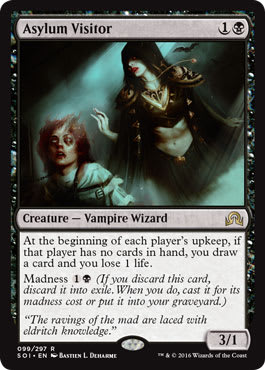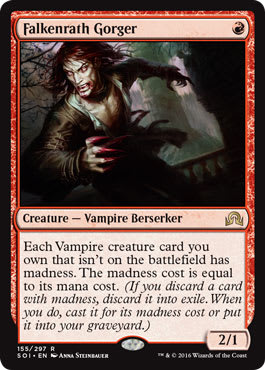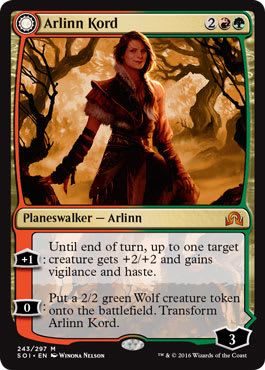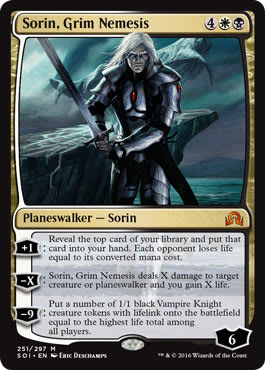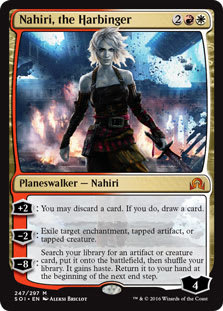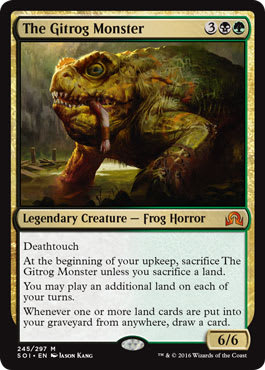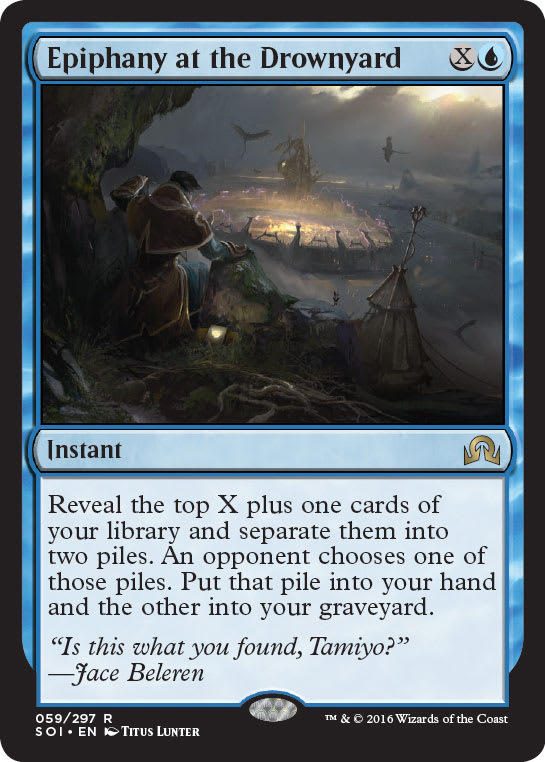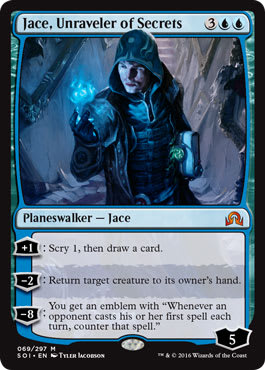During spoiler season, I test cards pretty extensively, and in this review, I'll be sharing evaluations of how these cards have been performing along with general evaluations on what Shadows over Innistrad brings to Cube archetypes. First, I'll discuss the set's mechanics.
Delirium
In my Oath of the Gatewatch colorless review, I talked about how cards like Thought-Knot Seer could be supported without adding support for colorless sources through cards like Blinkmoth Nexus, but all it really does is make them de facto control cards since aggressive decks won't have enough sources to make them castable in the early stages of the game. While it was a route that required more effort, I talked about how making sure that all archetypes have had access to colorless sources let the cards make them work well in all archetypes, which I've found was true, letting cards like Thought-Knot Seer and Reality Smasher find homes in aggro, midrange, and control.
Delirium has been similar, as I've found that, without explicit support, delirium was awkward, as it was easy to put two or three card types in the graveyard, but reaching the full four either requires the game dragging out for a while or using very specific cards, like Survival of the Fittest, to do so.
Much in the same way cards like Blinkmoth Nexus were already powerful enough for Cube but received new life by supporting diamond mana, cards like Hermit Druid, Merfolk Looter, and Victimize have new life breathed into them as they work with the graveyard in decks with and without delirium.
Cards like Thought-Knot Seer, Eldrazi Displacer, Mirrorpool, Reality Smasher, Bearer of Silence, and Matter Reshaper gave some solid payoffs for supporting colorless mana. Does this same paradigm exist for cards with delirium?
Well, not really. Even Inexorable Blob, To the Slaughter, Topplegeist, and Soul Swallower, the best delirium cards, still don't provide enough payoff to be worth it, as they're pretty mediocre without delirium. Inexorable Blob gives the best payoff for going into delirium since can become a lot of attacking power quickly, but it's still a bit low without more payoffs for delirium.
Madness
Madness isn't a new mechanic, but it is one with some new toys.
There previously wasn't much payoff for madness, as the cards weren't that good. Due to the low number of cards that would enable madness, they mainly needed to make the grade on their nonmadness merits, and a lot simply didn't.
This set's madness cards work better, as they're at least decently making the grade on nonmadness grounds—aside from Asylum Visitor, which is absurd even without madness. The current cards with madness in Shadows over Innistrad are just okay (From Under the Floorboards and Avacyn's Judgment), but unlike previous offerings, they are absurd if madness does happen.
The Cube-worthy cards with madness—From Under the Floorboards and Avacyn's Judgment—are better on both the baseline and with madness, with higher floors and ceilings than cards with delirium, and they’re decent to play without madness, although this matters more during gameplay, as they're merely okay in decks without madness. These cards mimic the best miracle cards for Cube, like Bonfire of the Damned, Entreat the Angels, and Terminus, as sorcery-speed Twin Bolt and a pseudo-Thragtusk are acceptable fail-case scenarios, but the payoff for having them paired with discard enablers is worth it. As with cards like Hermit Druid, including these cards in a Cube can be helped through cards like Rotting Rats, Frantic Search, and Survival of the Fittest. Because of this, it's easier to these madness cards than the set's delirium cards.
Skulk has only on one Cube-worthy card—Pale Rider of Trostad—and it's mostly a form of evasion on top of being a 3/3 for 2.
Investigate
The best Clue cards don't necessarily require for the game to drag on to the late game to be good, as it's closer to cards like the Rise of the Eldrazi levelers, which let you use “spare mana”—even if 2 mana to draw a card isn't the best rate for it. The best ones are also not in blue, which has easier-to-access premiere card-draw. They have some minor synergies with cards like Smokestack, Braids, Cabal Minion, Tangle Wire, and Tolarian Academy, which is nice for supporting those cards as well.
White
Archangel Avacyn starts things off with a bang, and although white 4-drops have historically been extremely competitive with Wraths, Armageddons, and cards like Restoration Angel, white 5-drops haven't. A lot are either straightforward finishers like Baneslayer Angel or value-generators like Cloudgoat Ranger and Karmic Guide.
Avacyn plays pretty closely to Baneslayer Angel as a big finisher (with flash and vigilance, making it great for control decks), and while it can kill your own aggro board, I've found that doesn't happen as much as one would fear. It's in the upper tier of white 5-drops occupied by only the best of the best—Baneslayer Angel and Reveillark—and cutting another white 5 or a non-Sun Titan 6-drop is a recommended change.
These represent some riffs on the standby of attacking 1s for white aggro decks.
Although a 1/2 for 1 isn't the best rate for an attacking creature, it's more for slower decks that can use her as a cheap blocker that can use the Clue, like a Wall of Omens in a way. She's made waves in Standard W/U Humans, but I have yet to see her do so in Cube aggro decks, but she's been a relatively late add.
Town Gossipmonger can't attack for 2 on turn one, but the tempo loss is a bit overstated, as it can transform by tapping the next creature cast. Having 3 toughness lets it push through value 2/2s incredibly well (and can even, on defense, transform after blocks), and like Firedrinker Satyr, it can even push through defensive Walls or do something more in the late game with its Firebreathing. The drawback of having to attack is annoying, but it's not been enough of one to singlehandedly exclude a card from being Cube-worthy, aside, arguably, from Tattermunge Maniac.
Both of these creatures help aggro decks by being serviceable bodies that put pressure on in the early game while giving value in the later stage, which we've seen with cards like Kargan Dragonlord and Student of Warfare in Cube. If you're looking to include these, I'd advise looking at creatures at the 2- to 3-mana ends of the curve unless your Cube aggro decks are finding that they're consistently cutting 1-drops, as it's more vital than cards like Seeker of the Way for aggressive decks.
While token-generators like Gideon, Ally of Zendikar are becoming better over the years and have been finding themselves at home in aggressive decks, they aren't necessary to make white aggro good—dedicated token decks are rare, and they're more of a subset of white Cube cards, not a strict identity. Always Watching compares directly to Glorious Anthem, and although it loses token synergy, it more than makes up with it through giving creatures vigilance, as it helps creatures race very well, which is an important function when needing to chump-attack with creatures but also needing a blocker or two to be back to chump-block.
I've asked other Cube designers for feedback on Always Watching and found that it tends to be in best in aggressive decks that are more focused on cheap, efficient threats, like Boros and recent W/U Humans decks, rather than those that go wide, like Orzhov tokens, although it's still fine there as well unless the deck goes extremely deep on tokens.
Declaration in Stone performs better in aggro decks that don't give the opponent time to crack the Clue or don't care that they do, a la Goblin Guide. It's unconditional removal and exiles, both of which can be nice against creatures like Wurmcoil Engine or Ulamog, the Ceaseless Hunger, even if it does so at sorcery speed because, while it isn't very efficient on a mana rate, it's an effective removal spell, even if the multiples and tokens clauses don't really happen very often. It compares directly to second-tier white removal like Temporal Isolation and Journey to Nowhere, and if you have either of those, it's an upgrade to those options.
Blue
Cards to consider:
Thing in the Ice is a payoff card, like Young Pyromancer, for drafting instant- and sorcery-heavy decks, rather than ones with a smattering of noncreatures, while doing what the deck wants to do (help you to stay alive). Like Young Pyromancer, it's not terribly efficient as a creature, and unlike Young Pyromancer, Thing in the Ice is all-or-nothing. Thing in the Ice can create board states where, once it loses a few counters, the opponent has to at least respect it becoming a 7/8 quickly after. Cards that perform basic functions of what a deck wants to do by pulling double-duty can (though not guaranteed) translate to Cube success, as cards like Quarantine Field and Mulldrifter have shown.
Black
Other cards to consider:
The archetype that received the biggest boost was black aggro. While it could certainly use more good 1-drops, as the ones that are good are extremely good, like Bloodsoaked Champion, there aren't that many of them. However, it received a ton of support at 2 mana.
Mark Rosewater talked about the phenomenon of “Additive Distraction," wherein people can focus on the wrong aspects of a card, and I've found that with Relentless Dead—there's temptation to think it's only good with other Zombies. Similarly to the this-requires-artifacts-to-be-good additive distraction with Whirler Rogue, Relentless Dead has been great even without other Zombies as a cheap creature with evasion that’s great at self-recursion (don't be scared and feel the need to play it with ![]() open; it's great at 2 mana), and it can actually block well, making it great if that's something that's needed.
open; it's great at 2 mana), and it can actually block well, making it great if that's something that's needed.
Asylum Visitor has performed extremely well, as it gives an actual payoff for making the opponent hellbent, which helps to cover the cases when you're unable to become hellbent yourself. Black having the most ways to make use of discard gives it the highest hope to use madness. Although I haven't found it happens too often, it's a nice bonus when it happens. Don't be discouraged that Blood Scrivener hasn't done much in Cube; this is several shades better and is one of the premiere 2-drops for black.
Heir of Falkenrath and Pale Rider of Trostad both are 3-power evasive creatures for 2 mana that make use of discard, although there are some minor differences in how (Pale Rider can just be cast as a 3/3 skulk for 2 when hellbent, and Heir of Falkenrath doesn't require discard until you want to transform it). Discarding a card for it can be a real cost and can set up for awkward two-for-one scenarios, but it's a cost that typically isn't too difficult for black aggro decks to pay, making them great for supporting black aggro decks.
Elusive Tormentor is pretty underrated currently, as it has a way to dodge removal, but it can be mana- and time-intensive to turn back into a threat. The drawback of the transformed side having 0 power can be mitigated with boosts, and it's pretty absurd with Swords, as it's nearly unkillable and presents a real clock. A few more Sword-grade Equipment will push it into more mainstream play, but given how weak Equipment has been lately, that may not happen for several years, if ever.
Through their discard, these cards work to allow some cross-pollinizing with reanimation strategies and giving cards to help straight-up Reanimator. Cards like Putrid Imp are only really good in that deck, so these cards give that archetype some multitaskers, like Oona's Prowler, to work with reanimation to pitch large creatures or work in aggro.
These can replace some second-rate black 2-drops like Nezumi Graverobber, but as black is shallow at 5-mana as well, this new class of black 2-drops can replace cards such as Priest of the Blood Rite, especially if they originally were included from abandoning black aggro. Pale Rider, due to its required discard (in most scenarios), is the worst out of the four, and it may be hard to find room for it along Asylum Visitor, Relentless Dead, and Heir of Falkenrath, but even if your Cube only has room for those three cards, it's a huge boost for black aggro.
Red
Cards to consider:
Falkenrath Gorger is an easy add for Cubes as an upgrade to Jackal Pup to supplement it, even if the Vampire madness ability is mostly flavor text.
Village Messenger works to get rid of some of the binary nature of Reckless Waif as being a card that isn't stone-useless when it's not transformed. It's had states in which it doesn't transform, regardless of power being played or not, mostly an upgrade on Reckless Waif. It's generally a nice, tier-two, red creature that is worse than the other 2-power 1-drops, but it’s a nice supplement to them.
Sin Prodder has worked well in red decks as a source of damage, whether it's in the form of actual damage or cards that translate to damage. It's a bit counterintuitive since Sin Prodder operates on a “Philosophy of Fire,” giving you advantages with either damage or sources of damage. There's an argument that all punisher cards are bad, but that isn't necessarily true. Cards like Edicts and creatures like Hellspark Elemental typically put an opponent where the player has a choice (block with my 2/2 and take 1 trample, or take 3).
It's easy to mentally shortcut cards that give an opponent the choice as bad, as they've historically been weak—cards like Browbeat put the opponent totally in control of how the card plays out—but Sin Prodder doesn't give ultimate control to the opponent. You still have a 3/2 menace for 3, and unless it immediately dies after, you have multiple turns to generate value, something that tends to be underrepresented in evaluation of cards that can last for multiple turns. While it's easy to mentally classify it as just a Boggart Brute, it ignores the reality that the 3/2 menace for 3 is only part of the package, not its entirety.
It's true the opponent does retain some control over what is done, and in decks that were low to the ground, it wasn't too difficult to bin a Jackal Pup (and take a damage), but when decks were revealing things like Goblin Rabblemaster and Blade Splicer, it became a bit harder, and it hit for more. As direct damage operates on efficiency axis (take 1 from Lightning Bolt or take 3 later), although there're some feel-bad moments from losing out on a Bolt, the opponent still took a damage, and I haven't found the fears of it making you lose a clutch card that you needed to be substantiated.
There aren't many attacking 3-drops in Cube, as a lot are still more value-oriented, but Sin Prodder's a good one at dealing damage and closing games.
Green
Other cards to consider:
Tireless Tracker impressed me a lot by working well with what green decks do just by playing Magic, but it obviously works better with cards like fetch lands or other lands that give multiple landfall triggers. It's played similarly to Courser of Kruphix by being a card that can snowball value over the course of the game by having Clues draw into more lands, which find more Clues, and so on, while being a gigantic threat. Since turn-one mana Elves have been deemed too powerful for Standard, we're seeing more pushed 3-drops like Nissa, Voice of Zendikar and Tireless Tracker. Welcome to the Cube family.
Regarding Duskwatch Recruiter, green Werewolves historically have tried to give mana sinks to make them better so that there's something to do other than pressing F6 on your turn (the average deck will draw a card). Although it costs 3 mana, it's nice at giving green attack decks something to do in the later stages of the game while having a decent body to attack with. It gives a lot of value, and it’s great in decks like R/G and G/U, which can play things on the opponent's turn (burn, counterspells, etc.). It is a fantastic green threat.
Last year on the podcast, we talked about “wingman” cards that can lean aggressively (but aren't solely aggressive cards) to support aggressive decks that play green as a second color. Both of these cards play that role exceptionally well.
Last, Everything Else
Cards to consider:
- Anguished Unmaking
- Arlinn Kord
- Sorin, Grim Nemesis
- Nahiri, the Harbinger
- Olivia, Mobilized for War
- The Gitrog Monster
- Westvale Abbey
Anguished Unmaking leads the multicolored all-stars by being extremely flexible and instant-speed. Paying 3 life is certainly a cost, as Thoughtseize has taught us, but just as with Thoughtseize, being able to have a flexible card that deals with threats at a relatively efficient rate is worth it.
Arlinn Kord is a pretty solid as a value card like the card it mimics, Huntmaster of the Fells. It has a ton of abilities, and we have seen where errors have occurred through incorrectly use, and it can be slow to “set up” for the mode where you want. It’s common for a player to make a Wolf and spam the +1 ability to act as a R/G Anthem-type effect. It could be a hard fit with Dragonlord Atarka, but it’s a very good one. This is the best R/G Planeswalker, better than Xenagos, the Reveler.
Sorin, Grim Nemesis somewhat compares to Chandra Nalaar as a Planeswalker that can take down a big threat, but Chandra Nalaar helped to cover a weakness in red (killing big things), whereas white and black don't tend to have that as a weakness; it's a strength. That said, if you have a smaller, multicolored section and count Lingering Souls as an Orzhov card, Sorin's gonna be a very hard fit as Anguished Unmaking edges it out.
Nahiri, the Harbinger breaks the mold as something for R/W to do that's more control-oriented than cards like Ajani Vengeant and Lightning Helix. I've found that it can be played around (if the opponent has a couple of big things), but it can work incredibly well with control strategies to gain card advantage through rummaging and killing attackers (even if the opponent can play around it). Her ultimate isn't necessarily a game-ender, but it can be great (and seems to be something judged more because she ultimates so quickly).
Olivia, Mobilized for War is a nice 3-drop that has great on-curve stats and, like Olivia Voldaren, is absurd if you untap with her, albeit for other reasons, as she can threaten a lot of damage either from aggressive threats or midrange, 4-or-more-mana beaters, but I have cooled down on her since the set came out.
The Gitrog Monster isn't so much an abstractly powerful card, but more a build-around with great potential, in a guild with rock-solid cards. Its requiring land sacrifice is a bit awkward for generic ramp since it can inhibit curving out to 6 mana for Titans, but it's a nice payoff for going turbo-ramp or drafting fetch lands.
Westvale Abbey is somewhat analogous to Kjeldoran Outpost–style cards that generate threats. It's pretty expensive to activate, but I've found the life-loss generally isn't too bad. I've found it works better in green and white decks, as they can have ways of producing multiple creatures, either via tokens or mana Elves, and I've seen and end-of-turn Secure the Wastes into Westvale Abbey already steal some games. Ormendahl, Profane Prince is stopped by bounce, sacrifice (sometimes), and exile effects, but I've found that's more unfounded fear than reality.
Here's an Orzhov aggro deck that recently 3–0’d a Cube Draft that features some of the cards from this set, such as Westvale Abbey and Asylum Visitor:
Orzhov Aggro ? Cube | Usman Jamil
- Creatures (14)
- 1 Asylum Visitor
- 1 Bygone Bishop
- 1 Dark Confidant
- 1 Dragon Hunter
- 1 Dryad Militant
- 1 Elite Vanguard
- 1 Flesh Carver
- 1 Heir of Falkenrath
- 1 Mardu Woe-Reaper
- 1 Soulfire Grand Master
- 1 Student of Warfare
- 1 Isamaru, Hound of Konda
- 1 Kalitas, Traitor of Ghet
- 1 Kytheon, Hero of Akros
- Planeswalkers (1)
- 1 Gideon, Ally of Zendikar
- Spells (10)
- 1 Anguished Unmaking
- 1 Path to Exile
- 1 Secure the Wastes
- 1 Chainer's Edict
- 1 Mind Twist
- 1 Spectral Procession
- 1 Vindicate
- 1 Faith's Fetters
- 1 Mox Emerald
- 1 Sensei's Divining Top
- Lands (15)
- 5 Plains
- 5 Swamp
- 1 Bloodstained Mire
- 1 Marsh Flats
- 1 Terramorphic Expanse
- 1 Westvale Abbey
- 1 Urborg, Tomb of Yawgmoth
Overrated
Last, I want to briefly cover some cards that look better than they are.
Hanweir Militia Captain — This is a bit too low-impact when not transforming. It needed an ability or two to make it worth using.
Epiphany at the Drownyard — This compares to Steam Augury, but as it was a multicolored card with a much higher barrier to entry, that isn't the most fair comparison. I did find that Epiphany was a bit underpowered until the later stages of the game, as it felt about a mana under where I'd want it to be.
Bygone Bishop — This is an upgrade to Mentor of the Meek by being slightly bigger and having evasion, but I found it suffered from similar symptoms: It was great when the card had fuel but pretty mediocre when the deck wasn't cooperating.
Geistblast — This combines the worst qualities of flashback cards: inefficiency on both ends and relatively marginal quality.
Goldnight Castigator — This is only really good when swinging for the win and atrocious otherwise.
Jace, Unraveler of Secrets — This compares pretty poorly with other 5-mana cards in blue (let alone Planeswalkers) and is a bit too low-impact at 5 mana, even if its +1 scry-and-draw ability is underestimated.
Skin Invasion — This is a bit too binary, more so than Werewolves. This is kinda like a Griffin Guide–type card or a way to work as “kicker” to removal spells, burn, or searing spells.
Conclusion
There've been a few articles talking about black being weak in Cube, with some reasons given that it ends up being too spread out and finding itself with cards that interact poorly with each other. In this set, it received a lot of cards that multitask for both aggro and reanimation. There hasn't been much for control decks aside from Sorin, Grim Nemesis and Nahiri, the Harbinger, and this set helps to push aggressive decks further.
If Eldritch Moon continues these themes—more aggressive cards, especially 1-drops in black and more delirium and madness payoff—I'll be a happy camper.
Thanks for reading!
@UsmanTheRad on Twitter
My blog, featuring my Pauper and powered Cube lists
Cube podcast, The Third Power, that Anthony Avitollo and I host
















